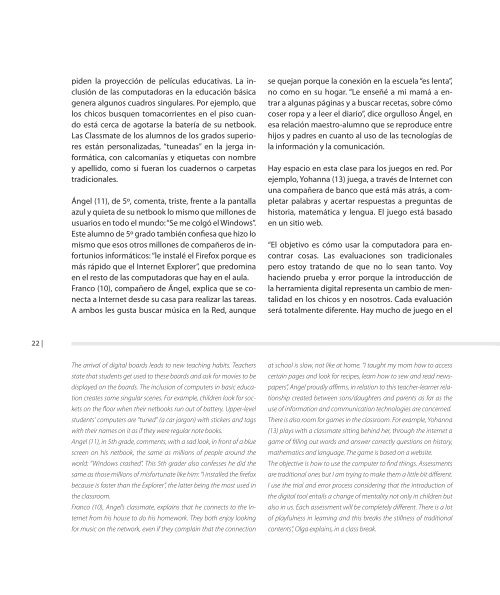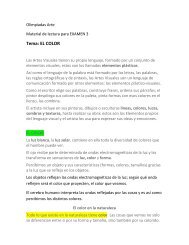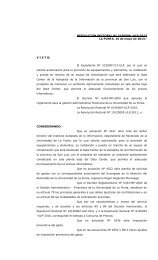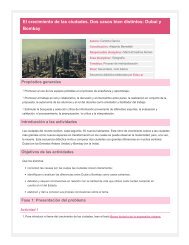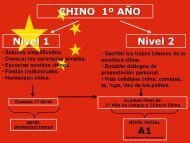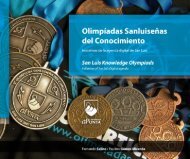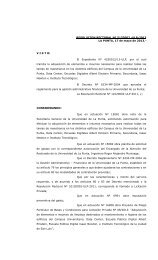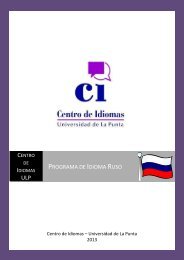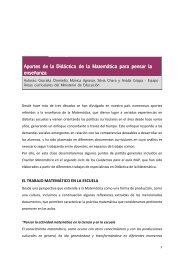pi<strong>de</strong>n la proyección <strong>de</strong> películas educativas. <strong>La</strong> inclusión<strong>de</strong> las computadoras en la educación básicagenera algunos cuadros singulares. Por ejemplo, quelos chicos busquen tomacorrientes en el piso cuandoestá cerca <strong>de</strong> agotarse la batería <strong>de</strong> su netbook.<strong>La</strong>s Classmate <strong>de</strong> los alumnos <strong>de</strong> los grados superioresestán personalizadas, “tuneadas” en la jerga informática,con calcomanías y etiquetas con nombrey apellido, como si fueran los cua<strong>de</strong>rnos o carpetastradicionales.Ángel (11), <strong>de</strong> 5º, comenta, triste, frente a la pantallaazul y quieta <strong>de</strong> su netbook lo mismo que millones <strong>de</strong>usuarios en todo el mundo: “Se me colgó el Windows”.Este alumno <strong>de</strong> 5º grado también confiesa que hizo lomismo que esos otros millones <strong>de</strong> compañeros <strong>de</strong> infortuniosinformáticos: “le instalé el Firefox porque esmás rápido que el Internet Explorer”, que predominaen el resto <strong>de</strong> las computadoras que hay en el aula.Franco (10), compañero <strong>de</strong> Ángel, explica que se conectaa Internet <strong>de</strong>s<strong>de</strong> su casa para realizar las tareas.A ambos les gusta buscar música en la Red, aunquese quejan porque la conexión en la escuela “es lenta”,no como en su hogar. “Le enseñé a mi mamá a entrara algunas páginas y a buscar recetas, sobre cómocoser ropa y a leer el diario”, dice orgulloso Ángel, enesa relación maestro-alumno que se reproduce entrehijos y padres en cuanto al uso <strong>de</strong> las tecnologías <strong>de</strong>la información y la comunicación.Hay espacio en esta clase para los juegos en red. Porejemplo, Yohanna (13) juega, a través <strong>de</strong> Internet conuna compañera <strong>de</strong> banco que está más atrás, a completarpalabras y acertar respuestas a preguntas <strong>de</strong>historia, matemática y lengua. El juego está basadoen un sitio web.“El objetivo es cómo usar la computadora para encontrarcosas. <strong>La</strong>s evaluaciones son tradicionalespero estoy tratando <strong>de</strong> que no lo sean tanto. Voyhaciendo prueba y error porque la introducción <strong>de</strong>la herramienta digital representa un cambio <strong>de</strong> mentalida<strong>de</strong>n los chicos y en nosotros. Cada evaluaciónserá totalmente diferente. Hay mucho <strong>de</strong> juego en el22 |The arrival of digital boards leads to new teaching habits. Teachersstate that stu<strong>de</strong>nts get used to these boards and ask for movies to bedisplayed on the boards. The inclusion of computers in basic educationcreates some singular scenes. For example, children look for socketson the floor when their netbooks run out of battery. Upper-levelstu<strong>de</strong>nts’ computers are “tuned” (a car jargon) with stickers and tagswith their names on it as if they were regular note books.Angel (11), in 5th gra<strong>de</strong>, comments, with a sad look, in front of a bluescreen on his netbook, the same as millions of people around theworld: “Windows crashed”. This 5th gra<strong>de</strong>r also confesses he did thesame as those millions of misfortunate like him: “I installed the firefoxbecause is faster than the Explorer”, the latter being the most used inthe classroom.Franco (10), Angel’s classmate, explains that he connects to the Internetfrom his house to do his homework. They both enjoy lookingfor music on the network, even if they complain that the connectionat school is slow, not like at home. “I taught my mom how to accesscertain pages and look for recipes, learn how to sew and read newspapers”,Angel proudly affirms, in relation to this teacher-learner relationshipcreated between sons/daughters and parents as far as theuse of information and communication technologies are concerned.There is also room for games in the classroom. For example, Yohanna(13) plays with a classmate sitting behind her, through the internet agame of filling out words and answer correctly questions on history,mathematics and language. The game is based on a website.The objective is how to use the computer to find things. Assessmentsare traditional ones but I am trying to make them a little bit different.I use the trial and error process consi<strong>de</strong>ring that the introduction ofthe digital tool entails a change of mentality not only in children butalso in us. Each assessment will be completely different. There is a lotof playfulness in learning and this breaks the stillness of traditionalcontents”, Olga explains, in a class break.
aprendizaje y esto rompe lo estanco que tienen loscontenidos tradicionales”, explica Olga, en un alto <strong>de</strong>la clase.“Yo tenía una resistencia total (Todos los Chicos en laRed, el mo<strong>de</strong>lo uno a uno provincial, que en la escuelaMaestro <strong>Punta</strong>no, arrancó en octubre <strong>de</strong> 2008). Nosoy una persona joven, estoy más cerca <strong>de</strong>l final <strong>de</strong>mi carrera que <strong>de</strong>l principio. Y este cambio implicaplanificar <strong>de</strong> otra manera, y apren<strong>de</strong>r. Me costó bastantea mí, y también les costó a los chicos enten<strong>de</strong>rel cambio. Me exigió abrir la mente, que un chicoaprenda una cosa, y que otro haga otra cosa. Pero eneste proceso me ayudó mucho una frase que se dijoen una <strong>de</strong> las capacitaciones que hice: ‘El niño no esuna botella para llenar sino una llama que hay queavivar’. Y en este proceso es posible admitir que ellos,los chicos, pue<strong>de</strong>n saber más que uno”, subraya.Mientras tratamos <strong>de</strong> salir <strong>de</strong>l asombro ante semejanteejemplo <strong>de</strong> humildad docente, llega a la escuela elinten<strong>de</strong>nte <strong>de</strong> Juana Koslay. Trae los uniformes parael <strong>de</strong>sfile <strong>de</strong>l Bicentenario que, unos días <strong>de</strong>spués,se realizará en Buenos Aires. Fueron premiados conel viaje a la Capital Fe<strong>de</strong>ral porque a finales <strong>de</strong>l 2009fueron los chicos que más aprendieron a partir <strong>de</strong> laintroducción <strong>de</strong> herramientas digitales en el aula. EnBuenos Aires representarán a la escuela, a la localidad<strong>de</strong> Donovan, a Juana Koslay y al mismo San Luis ensemejante <strong>de</strong>sfile.Es un momento único. Muchos chicos no pue<strong>de</strong>ncreer lo que tienen frente a sus ojos: una camperay un pantalón nuevo, a su medida. Cuando los reciben,algunos lo tocan con extremo cuidado; otrosno aguantan la ansiedad, se los prueban encima <strong>de</strong>lo que tienen puesto y preguntan al adulto que encuentrenmás cerca si les queda bien. Prepararse parael <strong>de</strong>sfile será una gran experiencia: muchos <strong>de</strong> estosalumnos viajarán por primera vez en su vida a laciudad <strong>de</strong> San Luis, aunque se encuentre a apenas 30kilómetros <strong>de</strong> sus casas. Para la mayoría será la primeravez que se suban a un micro <strong>de</strong> larga distancia| 23“I had an absolute refusal to this (the All Kids online project, the one toone provincial mo<strong>de</strong>l that was first implemented in this school in October2008). I am not a young person; I am more towards the end ofmy career than towards the beginning. And this change means planningin a different way, and learning. It took me some time, and it alsotook the children some time to un<strong>de</strong>rstand the change. It forced me toopen up my mind: one kid was learning something and another onewas doing something else at the same time. But in this process thereis a quote that helped me a lot and that was used during one of thetraining courses I took: ‘The kid is not a bottle to be filled but a flameto be revived’. And in this process it is possible to admit that childrencan know more than us”, she emphasizes.While we try to get over our surprise facing such an example of humilityfrom a teacher, the major of Juana Koslay gets to the school. Hebrings with him the uniforms for the Bicentenary para<strong>de</strong> that will takeplace a few days later in Buenos Aires. These stu<strong>de</strong>nts were awar<strong>de</strong>dwith this trip to the capital of Argentina because at the end of 2009they were the stu<strong>de</strong>nts who had learnt the most since the introductionof the digital tools in the classroom. In Buenos Aires they will representthe school, their town, Donovan, Juana Koslay and San Luisall together.It is a unique moment. Many of them cannot believe their eyes: anew pair of pants and a new coat, customized. When they get theuniforms, some of them touch the clothing with extreme care; someother cannot hold back their anxiety and they try the clothes on whatthey are wearing and ask people around if the uniform fits them well.Getting ready for the para<strong>de</strong> will be a fabulous experience: many ofthese stu<strong>de</strong>nts will travel for the first time to San Luis, even if it is located30 km away from their houses. For most of them, this will be thefirst time they will get on a long distance bus to go to Buenos Airesand be in front of the Cabildo and the Obelisk.While the ol<strong>de</strong>r children come and go around the school with their
- Page 3 and 4: »InitiativesHistorias de San Luis
- Page 5: »Historiasde San Luis DigitalIniti
- Page 8 and 9: Con estos antecedentes y una serie
- Page 10 and 11: El Gobierno de San Luis previó est
- Page 13: »ÍndiceIntroducciónCapítulo I -
- Page 16 and 17: 14 |Campus Universidad de La Punta
- Page 18 and 19: El presente libro registra voces de
- Page 20 and 21: Escuela provincial N° 192 “Maest
- Page 22 and 23: producciones de alfa, omega, epsil
- Page 26 and 27: para llegar a Buenos Aires y estar
- Page 28 and 29: en una fábrica. Ahora, con la ‘c
- Page 30 and 31: de cada provincia. La de San Luis v
- Page 32 and 33: A diferencia de la escuela de Donov
- Page 34 and 35: Escuela Nº 267 “Gobernador Eribe
- Page 36 and 37: Esta docente también dicta clases
- Page 38 and 39: Escuela Nº 267 “Gobernador Eribe
- Page 40 and 41: “Los chicos ya saben más que yo
- Page 42 and 43: “Cada docente tiene libertad para
- Page 44 and 45: para que los chicos puedan hacer tr
- Page 46 and 47: más de contemplar la meta de ofrec
- Page 48 and 49: en un horario preacordado en forma
- Page 50 and 51: mera obligación, terminará, y ent
- Page 52 and 53: 1º del Polimodal (hoy 3º año)”
- Page 54 and 55: comenzar a trabajar rápidamente. D
- Page 56 and 57: y trabajando en Piedra Bola y viaja
- Page 58 and 59: distancia no existe porque todo va
- Page 60 and 61: des que, sin rodeos, relata: “Est
- Page 62 and 63: e cómo buscar más material cuando
- Page 64 and 65: Plan de Inclusión Social (plan soc
- Page 66 and 67: Centro de Inclusión Digital de El
- Page 68 and 69: Claro que lo que sucede en el marco
- Page 70 and 71: signas”, pero busca superar esas
- Page 72 and 73: situación de vida, se atrevieron a
- Page 74 and 75:
porque dicen que, así, no me quedo
- Page 76 and 77:
La introducción de herramientas di
- Page 78 and 79:
“Trabajamos con los profesores, c
- Page 80 and 81:
su compresión más sencilla. Se tr
- Page 83 and 84:
»Capítulo IVTalleres de arte, jue
- Page 85 and 86:
Escuela 145 “Patricio Guanca” /
- Page 87 and 88:
alcanzar un objetivo les impide pro
- Page 89 and 90:
Natalia Miranda (12) es otra de las
- Page 91:
tengan mejores condiciones de vida,
- Page 94 and 95:
mas libres que, cuando terminan de
- Page 96 and 97:
La aspiración de Ester es “apren
- Page 98:
“Hace un año y medio que estoy e
- Page 101 and 102:
tra pero dejé para poder dedicarme
- Page 103:
en computadoras y arrancó con inge
- Page 106 and 107:
otra vez, que es el típico hospita
- Page 108 and 109:
Policlínico Regional de San Luis /
- Page 110 and 111:
Desde una habitación vecina, Lucas
- Page 112 and 113:
En el medio de estos dos grandes se
- Page 114 and 115:
112 |22 de agosto de 2008 - Entrega
- Page 116 and 117:
plementa con servicios gratuitos de
- Page 119 and 120:
»Capítulo XIConcluciones“Yo ten
- Page 121 and 122:
Oportunidad y cambio son dos palabr


